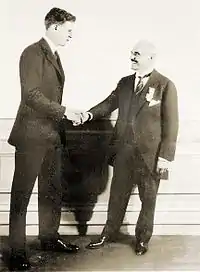Raymond Orteig
Raymond Orteig (1870 – 6 June 1939) was the New York City hotel owner who offered the Orteig Prize for the first non-stop transatlantic flight between New York City and Paris.

Early life and business activities
Orteig was born in the village of Louvie-Juzon in the region of Béarn in southern France. After spending part of his childhood looking after his father's sheep in the Pyrenees he emigrated at age 12, arriving in New York City on 13 October 1882 with 13 francs in his pocket to join an uncle living in New York City.[1] He started working as a bar porter at Wengler's Restaurant on William Street, New York City. Gaining experience he moved on to a position as waiter and then as a maitre'd at Martin Hotel on University Place on Ninth Street. By the time the owner Jean-Baptiste Martin moved uptown in 1902 Orteig was in a position to buy the hotel, which he renamed the Hotel Lafayette. In conjunction with a partner he was also able to lease the rundown Brevoort Hotel on the northeast corner of Fifth Avenue and Eight Street in Greenwich Village and later refurbish it.
The Lafayette became a favourite gathering spot for airmen during and after World War I and Orteig became acquainted with many of them including French officers on temporary duty in the United States to help build the US Air Force. After the end of the World War I, whenever he could, he and his family would spend the summer in Louvie-Juzon. This lifelong interest in the region of his birth lead to him expanding his business interests by the purchase of the Henri IV Hotel in Pau.
By his mid fifties Ortieg was in semi-retirement with daily operations at his establishments under the management of his three sons and his business partner Elie Daution. In 1925 the partnership undertook a $200,000 refurbishment of the Brevoort Hotel.
His support of and numerous charitable activities made him a leading figure in New York City's French community. This led to him being made a Chevalier of the Legion of Honour.[2]
Offer of the prize
In 1919 he attended a dinner in New York City organised by the Aero Club of America honouring the American flying ace Eddie Rickenbacker. Many of the speeches involved Franco-American friendship and Rickenbacher had looked forward to the day that the two countries were linked by air. Inspired by Rickenbacher's speech Orteig offered a prize of $25,000 to the first person of any Allied country to fly in one flight in either direction between New York City and Paris. The offer was made in a letter to Alan Ramsay Hawley president of the Aero Club of America on Thursday 22 May 1919. At the time relations were strained between America and France by negotiations at the Paris Peace Conference so as well as the encouragement of air travel and the public relations value to his business Orteig hoped that it would assist in a rapprochement between his adopted and native countries.[3] His offer was accepted by the Aero Club who set up a formal structure to administer it. The prize was valid for 5 years.
After its original term had expired Orteig reissued the prize on 1 June 1925 by depositing $25,000 in negotiable securities at the Bryant Bank with the awarding put under the control of a 7-member board of trustees.[4]
Orteig and his wife were on holiday in Pau, France, when he received a message from his son Raymond Jr that Charles Lindbergh had departed on his attempt. Orteig immediately travelled to Paris, arriving just before the Spirit of St. Louis touched down. He was able to meet Lindbergh at the American Embassy on 22 May 1927, eight years to the day since he had first offered the prize. Upon his depart from Paris to Belgium Lindbergh dropped a message of thanks to the local citizens from the Spirit of St. Louis as he flew over the Place de la Concorde. The message was attached to a French flag. Upon being retrieved the flag was presented to Orteig who displayed it on the wall of the Lafayette until his family removed it in protest at Lindbergh's involvement in the America First Movement.
Upon Lindbergh's return to America Orteig officially presented the prize to him on 16 June 1927 at a ceremony held in the reception hall of the Breevort Hotel in New York City. Over the preceding decade, the Orteig Prize became an inspiring incentive and marked a major shift in aviation progress during the late 1920s and early 1930s.[5][6]
Orteig died on 6 June 1939 in French Hospital in New York City after a long illness, with 500 people attending his funeral.[7]
He was married to French American Marie Ruisquès, by whom he had three sons, Evariste, Raymond Jr and Jean. The two oldest children married daughters of his longtime business partner Elie Daution.[8]
Notes
- Bak. Page 25.
- Bak. Page 28.
- Bak. Pages 28 and 29.
- Bak. Page 41.
- The Philanthropy Hall of Fame, Raymond Orteig
- Bak. Pages 222 and 223.
- Bak. Page 264.
- Bak. Page 28.
Further reading
- Bak, Richard (2011). The Big Jump - Lindbergh and the Great Atlantic Air Race (hardback). Hoboken: John Wiley & Sons. pp. 325 pages. ISBN 978-0-471-47752-5.
- Lalanne, Alain (2007). 'Du Béarn a New York, Raymond Orteig (1870–1939), Histoirie d'un mecene de l'aviation (paperback). Pau: Editions Marrimpouey. ISBN 2853021521. in French
